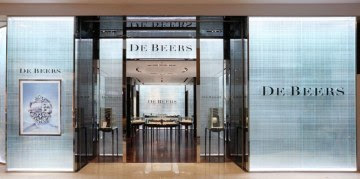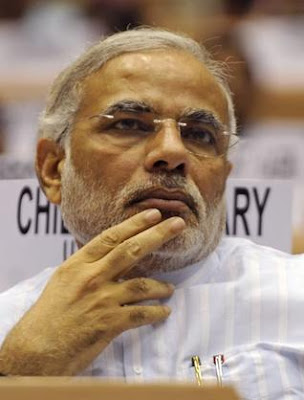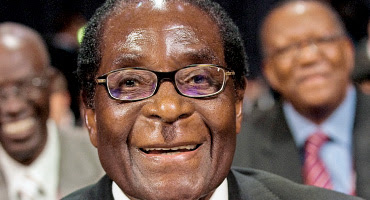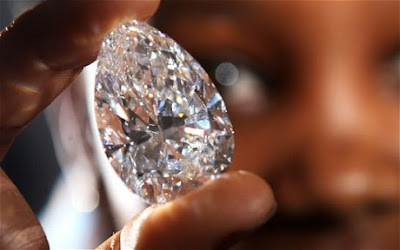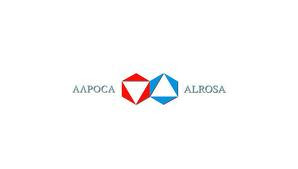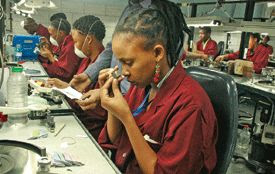
Tens of millions of dollars in diamond profits — perhaps more — are being secretly extracted from state-owned mines in eastern Zimbabwe, bypassing the nation’s treasury and raising fears that President Robert Mugabe is amassing wealth to help extend his 31-year reign, according to monitoring groups, diplomats, lawmakers and analysts.
President Robert Mugabe of Zimbabwe, center, at a meeting of Southern African leaders in Johannesburg in June. Kimberley Process Working Group of Diamond Experts, 2008
Stones from the Marange diamond fields in Zimbabwe. Some are gem quality, but many others are suitable only for industry.
Even if Mr. Mugabe’s allies in the mining ministry are telling the truth about the number of diamonds produced, the treasury was still shortchanged by at least $60 million last year, according to a budget report by the finance minister, one of the president’s chief opponents.
But the amount of money being withheld from the nation’s coffers may be much larger than that. Experts, and even some members of Mr. Mugabe’s own party, say the president’s allies are lowballing the nation’s diamond figures by millions of dollars, hoping to hide the fact that profits are being diverted for personal and political ends.
“The benefits of the diamond sales go primarily to allies of the president,” said Mike Davis, a specialist at Global Witness, a group that has extensively researched the contested mines in eastern Zimbabwe, known as the Marange fields. The strategy, Mr. Davis added, was “part of a wider attempt by people around Mugabe to seize the diamond wealth for their own political purposes, which in the short term means beating and cheating their way to another election.”
Now that Mr. Mugabe no longer controls the Finance Ministry — the result of a tenuous power-sharing arrangement to end the rampant state-sponsored violence during the 2008 presidential election — analysts say he needs outside income to finance his political operations. Diamonds offer him a rare opportunity to do that, especially now that international monitors have agreed to let Zimbabwe sell vast quantities of them, despite repeated warnings that it would enable Mr. Mugabe to tighten his grip on the nation.
Recent expenditures by Mr. Mugabe and his security forces have worried observers that unaccounted money from Marange, estimated to be one of the world’s richest troves because of its volume of diamonds, is financing his party’s groundwork for the early elections he is seeking next year.
The country’s defense forces, which answer to Mr. Mugabe and helped secure his victory in the last election by force, recently bought a large shipment of weapons and equipment from China, local news media reported. The mining ministry has paid millions of dollars in salary increases for civil servants outside its ranks, a form of patronage intended to win votes, according to some lawmakers and watchdog groups. And Anjin — a Chinese mining company in Marange that local and Western officials say the Zimbabwean military has a direct ownership stake in — is financing a new military academy.
“It’s quite clear that there’s much more money floating around than is justified by the level of economic activity,” said Eddie Cross, a Mugabe opponent in Parliament. He told the legislature in October that, based on information from geologists and production records, one company alone mined $1.4 billion in diamonds in Marange last year, far more than the $300 million the mining ministry had reported for all its operations there.
Questions about the diamonds have even caused some splintering within Mr. Mugabe’s party, ZANU-PF, as some benefit personally while others get cut out.
“I personally don’t think the numbers tally at all,” said a former senior ZANU-PF official, speaking anonymously to maintain relationships within the party. “When you look at the fields they are mining and how rich they are and what they later declare, you see that there must be a huge difference.”
“People are asking, ‘Where is the diamond money?’ ” the official added, “and the answers don’t seem to be coming out.”
While Mugabe officials deny any sleight of hand, other members of his party acknowledge that the nation’s mineral wealth does not always make it into the public treasury.
Edward T. Chindori-Chininga, a ZANU-PF member who is chairman of the Parliament’s committee on mines and energy, said that while 60 percent of the country’s exports came from mining, the sector accounted for only 10 to 15 percent of the government’s revenue. All of Zimbabwean mining, including platinum and gold, needs to make sure “that the money truly does come” to the treasury, he says, though he argues that there is no evidence of his party using any money improperly.
The diamonds have become a vivid symbol of Zimbabwe’s conflicts. International monitors and human rights groups say the army seized the Marange fields in 2008, using “horrific violence against civilians.” The Kimberley Process, an international coalition trying to prevent the trade of diamonds that fuel conflict, initially suspended trading from Marange. But in 2010, under pressure from some of Zimbabwe’s neighbors, it authorized two sales over objections from Western powers like the United States.
Zimbabwe sold an additional four million carats of diamonds in November 2010, and last month it was given official approval to export diamonds from Marange, drawing harsh criticism from human rights groups and some Western nations. Global Witness, which helped to establish the Kimberley Process, quit the coalition in protest last week.
Officials within Mr. Mugabe’s party insist that they have accurately reported all Marange revenue. “It is not possible in Zimbabwe to stash away anything by anybody,” said the mining minister, Obert Mpofu. “The systems are so tight. Everything that has been mined in this country, sold in this country, is accounted for.”
Critics, monitors and diplomats strongly disagree. “We hear very detailed reports of how sales are made through suitcases full of cash and antisanctions units in local banks,” said a Western official. “By those sales and revenue details not being conveyed in treasury figures, it leads many to believe that real sales are higher, possibly much higher.”
The political consequences could be stark. A military operation known as Operation Zhunde Ra Mambo, or “blessings of the chief,” financed by the ZANU-PF member who oversees the state’s interests at Marange, has deployed troops to rural areas to intimidate political opponents, according to one former opposition intelligence operative.
Mr. Mugabe has said the power-sharing deal is not working and has called for elections next year, a year ahead of schedule. Some analysts argue that Mr. Mugabe is pushing for elections because of his poor health — ZANU-PF would crumble or fracture without its leader — and to capitalize on the diamond wealth while he has it.
How much of the profits the nation’s coffers deserve is a matter of fierce debate. In his budget report, Finance Minister Tendai Biti said the government was entitled to at least 75 percent of gross proceeds, but received only 56 percent of reported earnings last year. Mining officials say the treasury got all it was owed.
But whether all the profits are being reported is another matter. One of the mining companies, Mbada, is owned by the state’s Zimbabwe Mining Development Corporation and The New Reclamation Group, a company based in the wealthy Johannesburg suburb of Sandton. The chairman of Mbada is Robert Mhlanga, Mr. Mugabe’s former pilot and a former member of the Zimbabwean defense forces.
A diamond production expert provided what he said were Mbada’s records for November 2010. They indicate that it produced between $100 million and $121 million worth of diamonds in that month, or possibly more than $1 billion that year. If accurate, that means a single company produced more than three times the amount claimed by the mining ministry for all of Marange.
Mr. Mhlanga and David Kassal, an owner of the New Reclamation Group, declined to comment. But skeptics abound.
“The people who are mining are ZANU-PF faithfuls,” said Moses Mare, another Mugabe opponent in Parliament. “They are not mining for the government. They are mining for their leaders.”




